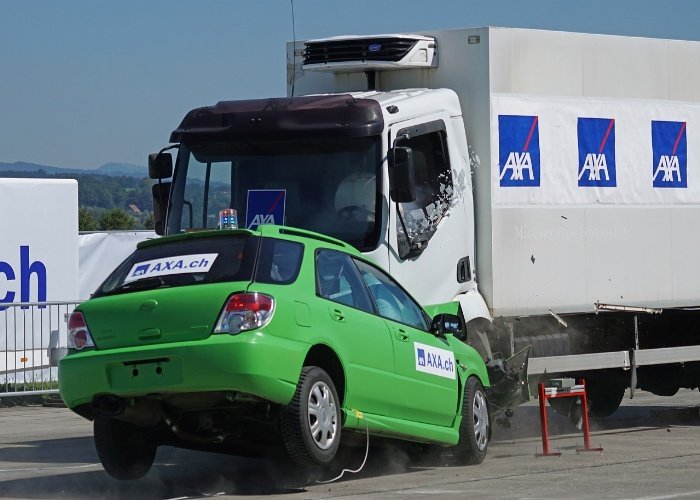Welcome to the concluding part of this article on The Chemistry Of airbag Automobile Protection System. In Part 1, we discussed the physics of car collision in which we explored very extensively the concept of momentum and basic laws of motion as they relate to vehicles on motion. We also discussed how an airbag helped to cushion the head against what would have been a fatal crash into the steering, dashboard or windscreen.
There has been arguments in some quarters against the effectiveness of airbags, with some doubters actually calling for proofs to authenticate the claims that airbags actually reduce fatalities. For this reason, therefore, in this Part 2, we will be looking at the effectiveness of airbags as accounted by a major research study that spans over a period of 8 years. We will also look at the Chemistry of airbag's gas generation and, finally, the mechanism of airbag deployment during a head-on collision.

[source: pixabay commons. CC0 licensed]
Airbags are very simple but also amazingly clever, because they have to open up at over 300 km/h (200mph)—faster than a car can crash! | Source
In the meantime, during the course of my research into airbags, I found the above quoted passage awe triggering, and can't help but appreciate the level of ingenuity of John W. Hetrick and Walter Linderer who are the known pioneers of the airbag automobile protection system ref. I mean it takes a lot of deep thinking and great imagination skills to come up with an idea of a system that will open up (within an enclosure) with a speed of over 300km/h, which is known to be even faster than the speed with which a car can crash! If you have ever done a speed of 150km/h with a car, you will simply join me to appreciate the ingenuity of these guys. The technology is simple but truly amazing! With that being said, can airbags be said to be effective and actually reduce crash fatalities? Let us see what the result of a major research has to say about this.
Effectiveness of airbags
According to the result of a major study that spanned over a period of 8 years precisely between 1985 to 1993, and published in 1995 by Adrian Lund and Susan Ferguson, it was found that, in comparison to cars fitted with only manual belts, airbags actually reduced fatalities by 23% — 24% in head-on collisions and by 16% in collisions of all kinds ref. The researchers wrote in conclusion:
...These analyses confirm that driver airbags are reducing fatalities in the frontal crashes for which they are designed. | Source
Even though the above result is true, airbag deployment has been described as "a contained and directed explosion, counteracting the violence of a collision with a structured violence of their own"ref. And by virtue of this, therefore, they also present the dangers of their own, with young children being the biggest risk and adults facing a small risk of eye injury and hearing lossref. It is reported that airbags installed from late 90's to present were designed to fire with less force than older ones, an improvement which has been shown to significantly reduce accidental deaths among Children.

[source: wikimedia commons. Author: Andreas Bohnenstengel. CC BY-SA 3.0 DE licensed]
How airbags are deployed
Timing is important if airbags must save life in a head-on collision. It must be able to deploy in a split of milliseconds following a collision impact, and must be prevented from deploying under situations of little or no profound impact. For this reason, one of the essential components of airbags is a sensor system which enables them to differentiate between the impacts resulting from a major accidental collision and those of minor incidentsref.
The most commonly used design for a crash sensor comprises a steel ball that can slide into a smooth bore. A permanent magnet or a stiff string holds this ball in position, preventing it from sliding into the bore when the vehicle runs over bumps or potholes. However, during a head-on crash when the vehicle decelerates very rapidly, the steel ball moves to slide inside the bore and in the process triggers on an electrical circuit, initiating the process of inflating the Airbagref.
A pellet of sodium axide is ignited following the triggering on of the electrical circuit. This is followed by a rapid reaction during which nitrogen gas is generated to fill a nylon or polyamide bag. It is reported that this process occurs under a time period of 40 milliseconds between the initial impact of the crash and full inflation of airbags ref.
The Chemistry of the gas generation
Airbags contain a gas generator which is a mixture of sodium axide (NaN3), potassium nitrate (KNO3), and silicon dioxide (SiO2). During a head-on collision after the triggering on of electrical circuit, a series of three chemical reactions take place to generate nitrogen to fill the airbag, and in the process, causes the decomposition of highly toxic sodium axide at 300oC to produce harmless glass.

[source: pixabay commons. CC0 licensed]
Explanation of the process and its chemical equations
The sudden deceleration of the vehicle signalled the sensor which then slides into the bore to trigger of electrical circuit following which the gas-generator mixture is ignited. This ignition creates a high temperature condition that's required for NaN3 to break down to give N2 which then fills the airbag.
2NaN3 ——> 2Na + 3N2
Both Potassium nitrate and silicon dioxide that are present in the gas-generator mixture primarily serve to remove sodium metal which is very explosive from the airbag by converting it into a harmless compound. To do this, metallic sodium from the first reaction reacts with potassium nitrate to produce sodium oxide, potassium oxide and more nitrogen gas and thus filling the airbag the more.
10Na + 2KNO3 ——> K2O + 5Na2O + N2
Both metal oxides are highly reactive and so it will be unsafe to allow them as the end product of the process. For this reason, both are then made to react with silicon dioxide to produce the harmless alkaline silicate glass according to the below equation:
K2O + Na2O + SiO2 ——> Na2K2SiO4 (alkaline silicate glass).
Conclusion
We have been able to demonstrate, by this two-part article, how airbags can help reduce the number and severity of injuries, as well as the number of deaths resulting from head-on collisions. This is achieved by cushioning the body against violently crashing into the steering, dashboard or windscreen. Thanks for reading.
References for further reading
Yours truly,
@eurogee
Do You Blog About Science, Technology, Engineering, and Mathematics? If Yes, Patiently Read The Below Info


Join Euronation Community on Telegram and whatsapp through the below links to socialize with larger steemit community:

No Witnesses = No Steem Blockchain; If You Truly Love Here, Vote For Witnesses NOW!
Click This Link To Vote Now


It is amazing the cleverness behind inventions such as this one. Imagine the amount of lives that have been saved thanks to this idea.
Very welcome
Congratulations, your post had been chosen by curators of eSteem Encouragement program. Feel free to join and reach us via Discord channel if you have any questions or would like to contribute.
Thank you for using eSteem
You are highly welcome
Airbags had saved a lot of lives!
Yes indeed
Congratulations @eurogee! You have received a personal award!
Click on the badge to view your Board of Honor.
Do not miss the last post from @steemitboard:
SteemitBoard World Cup Contest - The results, the winners and the prizes
This post has been voted on by the steemstem curation team and voting trail.
There is more to SteemSTEM than just writing posts, check here for some more tips on being a community member. You can also join our discord here to get to know the rest of the community!
Hi @eurogee!
Your post was upvoted by utopian.io in cooperation with steemstem - supporting knowledge, innovation and technological advancement on the Steem Blockchain.
Contribute to Open Source with utopian.io
Learn how to contribute on our website and join the new open source economy.
Want to chat? Join the Utopian Community on Discord https://discord.gg/h52nFrV
Have a chance at winning the 700 ETH jackpot by being the last key buyer in this Ethereum smart contract jackpot game https://exitscam.me/jackpot